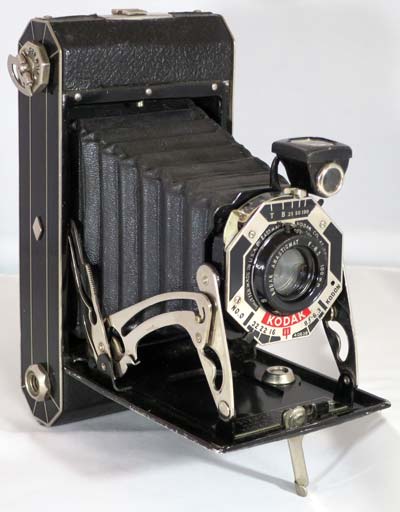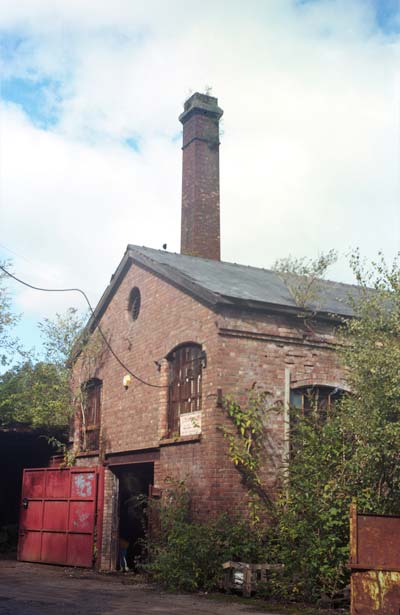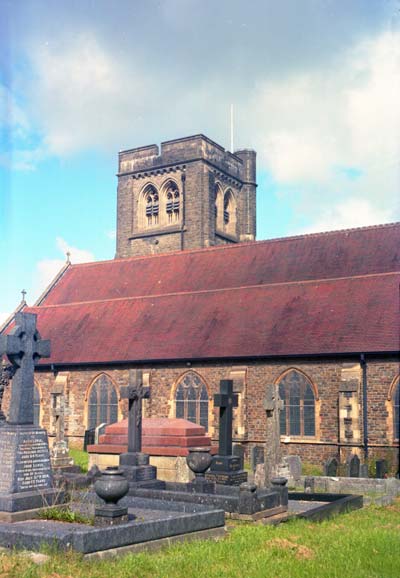Six-20 'Kodak'
Specification

| Manufacturer | : | Kodak |
|---|---|---|
| Produced | : | UK 1932 - 1933 |
| Classification | : | Medium Format |
| Body Type | : | Folding Bed |
| Bellows Deployment | : | Self Erecting |
| Construction | : | Metal |
| Film Type | : | 620 |
| Film Width | : | 62mm |
| ImageSize | : | 2¼ x 3¼ in |
| No. of Images | : | 8 |
| Lens Type | : | Kodak Anastigmat |
| Focus Type | : | Variable |
| Focal Length | : | 100mm |
| Focal Range | : | 3ft - inf. |
| Aperture Type | : | Iris |
| Aperture | : | f/6.3 - f/32 |
| Shutter Type | : | Kodon |
| Shutter Speeds | : | T,B,1/25,1/50,1/100 sec |
| Size Closed (w x h x d) | : | 80 x 150 x 32 mm |
| Size Open (w x h x d) | : | 80 x 150 x 121 mm |
| Weight | : | 485g |
Art Deco Credentials
![]()
![]()
![]()
![]()
![]()
Iconic: Famous, well-known and celebrated
- Produced during the main Art Deco period.
- Octagonal face plate design with red highlights.
- Ornate chrome struts.
- Angled ends to body.
- Enamelled side panels with nickel lines.
- Raised diamond and octagonal motifs
- Pig-grained leatherette
- Octagonal film winder
- Chrome and black enamel brilliant finder
Description
The Six-20 Kodak was introduced in 1932 but from 1933 it was redesigned to become the Six-20 model C. It is a self-erecting folding camera. It has angled ends to the body which is covered with pig-grained leatherette. It has a brilliant finders that swivels to cater for both portrait and landscape views. It does not have a folding frame finder. It features black enamelled side panels with nickel lines. The shutter plate is octagonal with chrome and black enamel deco pattern as well as bright red highlights. It has a swiveling red window cover. The struts are chrome and ornate unlike the redesigned Model C which are quite plain.
It supported two combinations of lens and shutter. These are a Doublet lens coupled with Kodon shutter or a Kodak Anastigmat f/6.3 with a Kodon shutter.
How to Use
Find the manual here:- Six-20 'Kodak'
This camera takes 620 film which is still available from selected photographic outlets. Although the actual film is the same as 120 film, the spools are different. The 620 spools are slightly shorter and have a smaller diameter. Do not use 120 film in this camera because it will jam and may snap. It is possible to cut down a spool of 120 film to fit or to re-spool some 120 film onto 620 spools in a darkroom or changing bag.
If you are concerned about the exposure settings for this camera then don't worry. Either use the 'Sunny 16 rule' or the more simple 'Outdoor 8' rule.
The Outdoor 8 rule says that when shooting images outside in summer, in the middle of the day, set your shutter speed to reciprocal of the film ISO you are using. Then set your aperture to f/8. For example, if you are using ISO 100 film, then set your shutter speed to 1/100s (or as close as possible) and your aperture to f/8.
This works due to the latitude of negative film. In bright sunshine, your film will be 2 stops overexposed whereas in overcast weather your film will be exposed correctly. In heavy overcast conditions, your film will be 1 stop underexposed. Modern films can deal with this variation easily, even when developed normally.
Photographs taken with this Camera
Using Kodak Portra 160 film. Developed in Tetenal.



